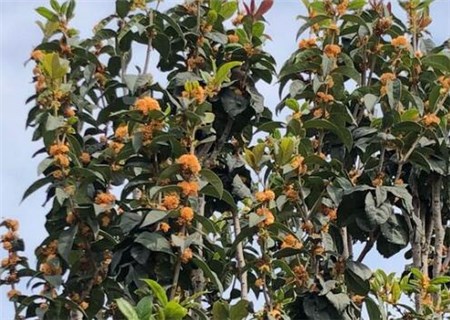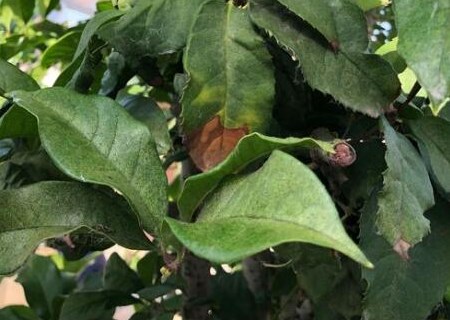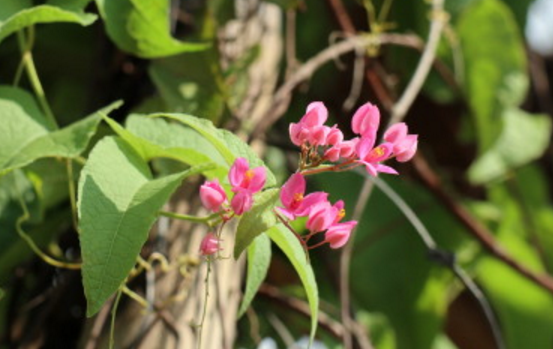What are the cultivation methods of Osmanthus fragrans in Oleaceae? How to control diseases and insect pests? How long do you usually live?
Sweet-scented osmanthus tea made from sweet-scented osmanthus is a Chinese specialty tea. It has a soft aroma and delicious taste, and is loved by the public. Osmanthus fragrans is widely used in garden construction. So do you know the cultivation methods of sweet-scented osmanthus trees? How to control diseases and insect pests? How long do you usually live?

What are the cultivation methods of sweet-scented osmanthus trees
1. Sowing: the fruit of sweet-scented osmanthus usually matures from April to May and can be harvested when the pericarp changes from green to purple-black. Sweet-scented osmanthus seeds have the role of post-ripening, it should be stored in sand for at least half a year, sprinkle water and pile up after harvest, remove the pulp, place in a cool place to dry the seeds naturally, store them with mixed sand, and sow in autumn or spring after sand storage. Before sowing, the ground should be well prepared, and enough basic fertilizer should be applied. It can also be sowed in the indoor seedbed. When sowing, put the seed navel on the side to avoid the bending of radicle and young stem, which will affect the growth of seedlings in the future.
2. Grafting: sweet-scented osmanthus grafted rootstocks are mostly used in privet, lobular privet, wax, water wax, etc., and lobular privet is used in mass propagation of seedlings. Before spring germination, cut the rootstock from 5 cm above the ground, cut the thick 1-2-year-old branches of sweet-scented osmanthus 10-12 cm in length, cut 2-3 cm in length on one side of the base, cut a 45-degree slope on the opposite side, cut longitudinally at about 1x3 on one side of the rootstock, about 2 cm deep, insert the scion into the incision, align the cambium, tie it up with a plastic bag, and then bury it in the soil.
3. Cutting: usually before sprouting in spring, the annual branches are cut into 5-10 cm long, the lower leaves are cut off, and the upper 2-3 green leaves are left in the river sand or loess seedbed, the plant row spacing is 3-20 cm, irrigation or spraying water in time after planting, and shading, keep the temperature 20: 25 ℃, relative humidity 85: 90% can take root and transplant after 2 months.
4. Striping: sweet-scented osmanthus can be divided into two types: low pressure and high pressure. the low pressure method is to select the flexible parts of the 1 ~ 2-year-old branches of the lower part of the low dry mother tree from spring to early summer, cut or ring-peeled and pressed into the grooves 3cm deep and fixed with wood strips. The high-pressure method is to cut or peel 1-2-year-old stout branches from the mother tree in spring with the same low-pressure method, then smear the wound with culture medium, fasten it up and down with plastic bags, and cut off the mother plant for maintenance in autumn.
2. How to control diseases and insect pests in sweet-scented osmanthus trees
Brown spot disease
In the early stage of the disease, chlorotic small yellow spots appeared on the leaves, which gradually expanded into near-round spots, with a diameter of 2-10mm, or irregular spots due to the limitation of leaf veins. The disease spot is yellowish brown to grayish brown with a yellow halo on the periphery of the spot. Brown spot usually occurs from April to October, and old leaves are more susceptible to the disease than young ones. The pathogen overwintered on the diseased fallen leaves with hyphae and produced conidia for primary infection in the following spring. The conidia were transmitted by airflow and raindrops.
Blight spot
The pathogen of the disease mostly invaded from the leaf edge and leaf tip, and occurred at the leaf edge and leaf tip. In the early stage of the disease, light brown dots appeared on the leaves, which gradually expanded into round or irregular plaques, and then expanded into near round or irregular grayish brown spots, with dark brown edges. Blight occurs from July to November and can occur all year round in greenhouses with poor environmental conditions. The pathogen is infected by conidia through wind and water. The environment of high temperature, high humidity and poor ventilation is beneficial to the disease. The disease was more serious in the old leaves and lower leaves of the plant during the weakening of plant growth and after overwintering.
Anthrax
The disease infects sweet-scented osmanthus leaves. At the initial stage of the disease, small chlorotic spots appeared on the leaves, and gradually enlarged to form round, semicircular or oval spots. The disease spot is light brown to grayish white, with reddish-brown rings on the edge. Under moist conditions, a pink myxospore disk appears on the spot. Anthrax occurs from April to June. The pathogen overwintered in diseased leaves with conidia and was transmitted by wind and rain.
Prevention and cure measures
First of all, the source of infection should be reduced. Thoroughly remove the diseased leaves in autumn. Potted sweet-scented osmanthus should remove the diseased leaves in time. Secondly, strengthen the cultivation management. Select fertile and well-drained soil or substrate to plant sweet-scented osmanthus; increase the application of organic fertilizer and potassium fertilizer; planting density should be suitable for ventilation and light transmission, reduce leaf humidity and reduce the occurrence of diseases.
Scientific use of chemicals for prevention and control. At the initial stage of the disease, spray 1V 2v 200 times Bordeaux liquid, and then spray 50% carbendazim wettable powder 1000 times or 50% benzoate wettable powder 1000-1500 times. The serious disease area should be soaked and disinfected with 1000 times potassium permanganate solution when the seedlings came out of the nursery.
Pest control
The main pest of family breeding sweet-scented osmanthus is mites, commonly known as red spiders. Once the disease is found, it should be disposed of immediately, and foliar spray can be carried out with mite, aphid and triazoltin. Spray both sides of the blade evenly. Once a week, 2-3 times in a row, can be cured.
3. How long can sweet-scented osmanthus trees live
When it comes to its life span, in fact, we can use one word to interpret it, that is, "long". So how long is it? There must be no problem for at least a few decades, and some can even last as long as a hundred years. The reason why sweet-scented osmanthus trees live so long is mainly because they have fewer diseases and insects and have a strong ability to adapt to the environment.
Time: 2019-03-17 Click:
- Prev

What if the leaves of the traditional sweet-scented osmanthus trees are dry and yellow? Why can't you grow it at home? How to grow well?
Sweet-scented osmanthus is a common name for many trees of the genus Oleaceae in China. It is an evergreen shrub or small tree of Oleaceae. It has a wide variety of gardening, so do you know what to do when the leaves of sweet-scented osmanthus are withered and yellowed during planting? Why can't you grow it at home? How to grow well? What about the withered and yellow leaves of sweet-scented osmanthus trees?
- Next

How to raise the coral vine balcony of Polygonaceae? What about the withered and yellow leaves of the seedlings? What's the use?
Coral vine is eye-catching and spectacular, it is a good plant for garden and vertical greening, and it is also one of the flowers with ornamental value, so how to raise coral vine balcony? What about the withered and yellow leaves of the seedlings? What's the use? According to information, coral vines like a humid environment, so they should be fully watered during their growth. Keep the soil moist
Related
- Fuxing push coffee new agricultural production and marketing class: lack of small-scale processing plants
- Jujube rice field leisure farm deep ploughing Yilan for five years to create a space for organic food and play
- Nongyu Farm-A trial of organic papaya for brave women with advanced technology
- Four points for attention in the prevention and control of diseases and insect pests of edible fungi
- How to add nutrient solution to Edible Fungi
- Is there any good way to control edible fungus mites?
- Open Inoculation Technology of Edible Fungi
- Is there any clever way to use fertilizer for edible fungus in winter?
- What agents are used to kill the pathogens of edible fungi in the mushroom shed?
- Rapid drying of Edible Fungi

